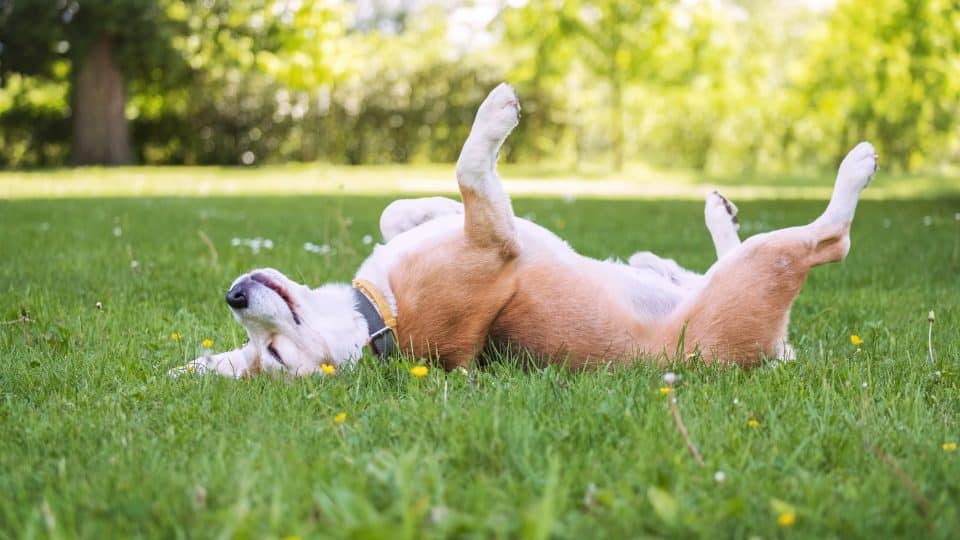Why Do Dogs Roll on Their Back in Grass?
Dogs are fascinating creatures that exhibit a wide range of behaviors, some of which may seem peculiar to us humans. One such behavior that often captures our attention is when dogs roll on their backs in the grass. It is a common sight to see our furry friends joyfully flopping onto their backs, legs flailing in the air, and rolling around with sheer delight. But what exactly motivates dogs to engage in this seemingly odd behavior?
To understand why dogs roll on their backs in the grass, we need to delve into their instincts and behaviors rooted in their ancestral heritage. Dogs are descendants of wolves, and despite centuries of domestication, they still retain many of their primal instincts. Rolling on their backs is a behavior that can be traced back to their wild ancestors.
One primary reason behind this behavior is communication. When a dog rolls on its back, it exposes its vulnerable belly, which is a submissive gesture in the canine world. By doing so, dogs are signaling to other dogs or even humans that they pose no threat and are willing to submit. It is a way for them to convey trust and establish social bonds.
Moreover, rolling on their backs also serves as a means of sensory exploration. Dogs have an incredible sense of smell, and the grass provides a plethora of intriguing scents. By rolling on their backs, dogs can effectively expose their noses to the ground, allowing them to fully immerse themselves in the olfactory experience. It is their way of gathering information about their surroundings and the creatures that may have passed through the area.
Additionally, rolling on their backs in the grass can simply be a pleasurable experience for dogs. It provides them with a sense of freedom, allowing them to indulge in their natural instincts and enjoy the sensation of the grass against their fur. It can be likened to humans lying down on a soft bed or reclining on a comfortable couch after a long day. Dogs find solace and relaxation in this act, which can contribute to their overall well-being and happiness.

Why Do Dogs Roll on their Back in Grass
In conclusion, dogs rolling on their backs in the grass is a behavior deeply rooted in their evolutionary history. It serves as a form of communication, a means of sensory exploration, and a source of pleasure for our furry companions. So, the next time you see your dog happily rolling around in the grass, remember that they are simply embracing their instincts and finding joy in the simple pleasures of life.
The Fascinating Behavior of Dogs Rolling on Their Back in Grass
The Instinctual Communication
One of the key reasons why dogs roll on their backs in the grass is rooted in their instinctual communication. As descendants of wolves, dogs have inherited various behaviors that were crucial for survival in the wild. Rolling on their backs is a submissive gesture that signals to other dogs or even humans that they pose no threat. By exposing their vulnerable belly, dogs are essentially saying, “I trust you” and seeking to establish social bonds. This behavior is particularly evident during playtime or when encountering new dogs or people.
Sensory Exploration
Another fascinating aspect of dogs rolling on their backs in the grass is their innate drive for sensory exploration. Dogs have an exceptional sense of smell, and the grass provides a rich tapestry of scents. When they roll on their backs, their noses come in direct contact with the ground, allowing them to fully immerse themselves in the olfactory experience. They can gather information about their environment, such as detecting the presence of other animals or identifying familiar scents. It’s their way of staying connected with their surroundings and understanding the world through their keen sense of smell.
Pleasure and Relaxation
Beyond communication and sensory exploration, rolling on their backs in the grass is simply a pleasurable experience for dogs. It offers them a sense of freedom and allows them to indulge in their natural instincts. The feeling of the grass against their fur can be soothing and comforting, akin to how humans find relaxation when lying down on a soft bed or reclining on a comfortable couch. This act of rolling provides dogs with a moment of bliss and contributes to their overall well-being and happiness.
Physical and Behavioral Benefits
Rolling on their backs in the grass also brings about physical and behavioral benefits for dogs. It can help them stretch their muscles, relieve tension, and promote flexibility. The act of rolling can also serve as a form of self-soothing, helping dogs alleviate stress or anxiety. Additionally, this behavior can be a way for dogs to cool down on a hot day, as the grass provides a cooler surface compared to the pavement or indoors.
Conclusions
In conclusion, if you’re curious about more quirky dog behaviors such as “Why Do Dogs Roll on Their Back in Grass,” head over to geepets.com. This website is a treasure trove of information on dog behavior, training tips, and health advice that can help you better understand and care for your furry friend. For additional insights and expert opinions on dog behaviors and their underlying reasons, the American Kennel Club (akc.org) offers a wealth of resources. Their articles and guides are written by dog experts and veterinarians, providing reliable and in-depth information on a wide range of dog-related topics.

Why Do Dogs Roll on their Back in Grass
Practical Recommendations for Understanding and Supporting Dogs Rolling on Their Back in Grass
1. Allow Safe and Encouraging Environments
Creating a safe and encouraging environment for your dog to roll on their back in the grass is crucial for their well-being and happiness. This natural behavior, often prompted by the question, “Why do dogs roll on their back in grass?” can be attributed to various reasons ranging from scent masking to simple enjoyment.
When ensuring the area is free from potential hazards such as sharp objects or toxic plants, you’re addressing the fundamental concerns that come with understanding why do dogs roll on their back in grass. Providing a spacious and grassy area in your backyard or visiting dog-friendly parks can offer ample opportunities for your furry companion to engage in this behavior, which is deeply rooted in the question of why do dogs roll on their back in grass.
In creating these opportunities, it’s important to consider the underlying reasons behind why do dogs roll on their back in grass. This behavior can serve as a means for them to cool down on a hot day, relieve an itch, or even spread their scent. By recognizing and facilitating a secure environment for them to perform this act, you’re not only catering to their instinctual needs but also enriching their outdoor experiences. Thus, understanding and accommodating the reasons behind why do dogs roll on their back in grass is essential in fostering a happy and healthy lifestyle for your pet.
2. Observe and Respect Their Communication
When your dog rolls on their back in the grass, a behavior often questioned as “Why Do Dogs Roll on Their Back in Grass,” it’s crucial to observe and respect their method of communication. Recognizing this action, which might prompt the query, “Why Do Dogs Roll on Their Back in Grass,” as a sign of trust and submission is essential.
It’s advisable not to interrupt or disturb them during this time, as doing so might disrupt their sense of security and hinder their ability to establish social bonds with other dogs or humans. Understanding the “Why Do Dogs Roll on Their Back in Grass” behavior signifies more than a quirky habit; it’s a window into your dog’s emotional state and social well-being.
3. Encourage Positive Reinforcement
Use positive reinforcement techniques to encourage and reinforce the behavior of rolling on their back in the grass. Praise and reward your dog when they engage in this behavior, either through verbal cues or treats. This will help them associate rolling with positive experiences, further encouraging them to continue this natural behavior.
4. Provide Mental and Physical Stimulation
Ensure that your dog receives adequate mental and physical stimulation to prevent boredom and promote overall well-being. Engage in regular play sessions, provide interactive toys, and incorporate training exercises that challenge their minds. A stimulated dog is less likely to engage in destructive behaviors and more likely to find satisfaction in rolling on their back in the grass.
5. Regular Veterinary Check-ups
Scheduling regular veterinary check-ups is paramount to ensure your dog’s health and well-being. It’s crucial to discuss any concerns or unusual behaviors with your veterinarian, especially if you notice behaviors like excessive rolling on their back. This specific action might lead you to wonder, “Why do dogs roll on their back in grass?” and whether it’s a normal part of their behavior or indicative of something more.
When you bring up the question, “Why do dogs roll on their back in grass?” with your veterinarian, they can delve into the behavior, assessing if any underlying medical conditions may be causing discomfort or affecting your dog’s inclination towards this action.
Understanding “Why do dogs roll on their back in grass?” is essential, as it can sometimes be a sign of skin irritations, allergies, or even a way for your dog to cool down. However, without a professional assessment, it’s difficult to determine the exact reason. By discussing “Why do dogs roll on their back in grass?” you open up a dialogue that allows your vet to provide insights or suggest further investigations if they suspect it’s linked to an underlying health issue.
Moreover, inquiring about “Why do dogs roll on their back in grass?” during veterinary visits emphasizes the importance of being proactive about your dog’s health. It ensures that any peculiar behavior is not overlooked but rather evaluated by a professional who can offer guidance or treatment options. This approach not only addresses potential health concerns but also enhances your understanding of your dog’s behaviors and needs.

Why Do Dogs Roll on their Back in Grass
6. Seek Professional Guidance if Needed
If you have concerns about your dog’s behavior or if rolling on their back in the grass becomes excessive or problematic, it’s crucial to understand the behavior from a comprehensive perspective. Many pet owners ask, “Why Do Dogs Roll on Their Back in Grass?” This behavior is common and can have several explanations, ranging from enjoying a cool sensation to trying to mask their scent.
However, if you find yourself repeatedly questioning, “Why Do Dogs Roll on Their Back in Grass?” and it seems to be more than a simple quirk or pleasure activity, it might indicate an underlying issue that needs addressing.
When the question “Why Do Dogs Roll on Their Back in Grass?” arises frequently and you’re concerned about the excessive nature of this behavior, it’s advisable to seek professional guidance. A certified dog trainer or an animal behaviorist can offer valuable insights into this behavior. They can provide personalized strategies and guidance to address any specific issues linked to the question of “Why Do Dogs Roll on Their Back in Grass?” ensuring your dog’s well-being.
Professionals can help dissect the reasons behind the behavior, offering solutions tailored to your dog’s needs and possibly providing peace of mind to you as an owner. They understand the nuances of canine behavior and can answer the persistent question of “Why Do Dogs Roll on Their Back in Grass?” with authority and accuracy. Their expertise can be instrumental in transforming this potentially problematic behavior into an understanding of your dog’s needs and habits.
7. Embrace the Joy and Let Them Be
Above all, embrace the joy that dogs experience when rolling on their back in the grass. Allow them to fully indulge in this natural behavior, as it brings them happiness and fulfillment. Take a moment to appreciate the simple pleasures that nature provides for our furry friends and cherish the special bond you share with your canine companion.
Remember, understanding and supporting your dog’s behavior of rolling on their back in the grass contributes to their overall physical and emotional well-being. By creating a safe environment, respecting their communication, and providing appropriate stimulation, you can ensure that your dog enjoys this instinctual behavior to the fullest.






















